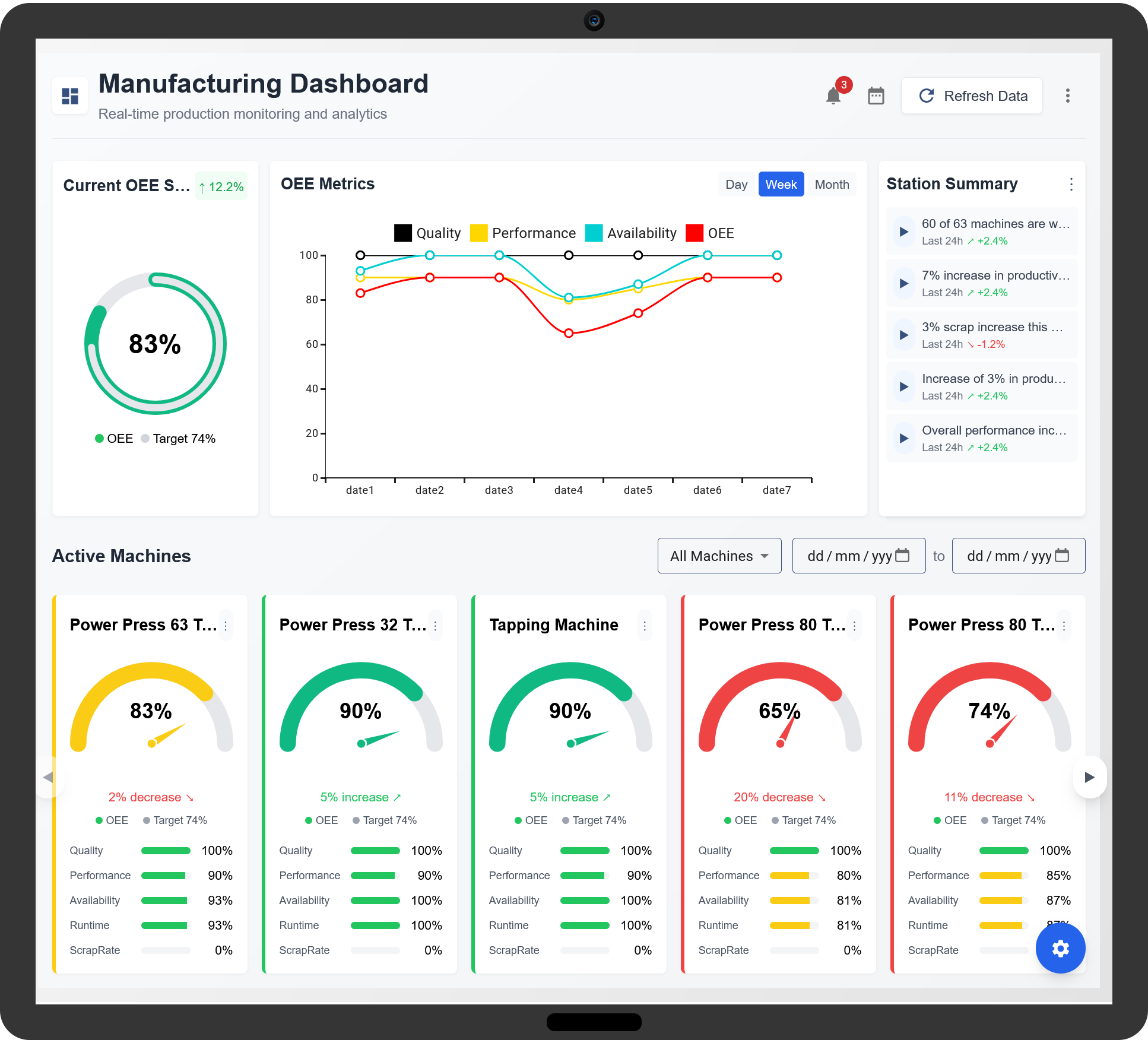In modern manufacturing, efficiency is a key factor in maintaining competitiveness and profitability. OEE (Overall Equipment Effectiveness) software plays a crucial role in optimizing production by monitoring equipment performance, identifying inefficiencies, and providing real-time data for informed decision-making. By leveraging OEE software, manufacturers can maximize productivity, minimize downtime, and enhance overall operational effectiveness.

1. Understanding OEE and Its Importance
OEE is a standardized metric used to evaluate the efficiency of manufacturing processes. It consists of three core components:
- Availability: Measures the percentage of time equipment is available for production compared to planned operational time.
- Performance: Evaluates the speed at which equipment operates relative to its optimal production capacity.
- Quality: Assesses the proportion of defect-free products compared to total production output.
By combining these three factors, OEE software provides a single efficiency score, enabling manufacturers to measure and improve productivity.
2. Key Features of OEE Software
OEE software is designed to streamline manufacturing processes by offering a range of features that provide actionable insights. These features include:
- Real-Time Data Collection: Captures live production data from machines, allowing instant performance analysis.
- Downtime Analysis: Identifies the root causes of unplanned downtime and helps implement corrective actions.
- Automated Reporting: Generates detailed reports and visual dashboards to monitor performance trends.
- Performance Benchmarking: Compares equipment efficiency across different production lines and shifts.
- Quality Tracking: Monitors defect rates and ensures adherence to manufacturing standards.
- Predictive Maintenance: Uses historical data to anticipate potential failures and schedule preventive maintenance.
3. Benefits of OEE Software in Manufacturing
Implementing OEE software offers significant advantages to manufacturing operations, including:
- Increased Productivity: Helps identify inefficiencies and optimize production schedules.
- Reduced Downtime: Detects issues in real time, allowing quick resolution of equipment failures.
- Enhanced Product Quality: Minimizes defects by ensuring consistent monitoring of production processes.
- Better Resource Utilization: Ensures that machines and labor are used to their full potential.
- Improved Decision-Making: Provides data-driven insights for optimizing manufacturing strategies.
4. Steps to Implement OEE Software
For successful deployment of OEE software, manufacturers should follow these key steps:
- Define Objectives: Identify key areas of improvement and establish OEE targets.
- Select the Right Software: Choose a solution that aligns with production needs and integrates with existing systems.
- Integrate with Production Equipment: Ensure seamless data collection from machines and production lines.
- Train Employees: Educate operators and managers on how to use the software effectively.
- Monitor and Optimize: Continuously analyze performance data and implement improvements.
5. Customizing OEE Reports for Better Insights
OEE software allows manufacturers to generate customized reports tailored to their specific operational needs. These reports include:
- Shift Performance Reports: Evaluates efficiency across different work shifts.
- Machine Utilization Reports: Identifies underperforming equipment and potential bottlenecks.
- Quality Control Reports: Tracks defect rates and ensures compliance with production standards.
- Trend Analysis Reports: Highlights long-term efficiency patterns and areas for improvement.
6. Challenges in Implementing OEE Software
While OEE software provides significant benefits, manufacturers may face challenges such as:
- Data Accuracy: Ensuring accurate data collection through proper calibration of sensors.
- System Integration: Seamlessly connecting OEE software with other manufacturing systems.
- Employee Adoption: Encouraging staff to actively use the software for monitoring and reporting.
- Continuous Improvement: Regularly updating the system to align with evolving manufacturing needs.
7. Future Trends in OEE Software
As manufacturing continues to evolve, OEE software is also advancing with new technological trends, including:
- AI-Powered Analytics: Uses artificial intelligence to predict inefficiencies and suggest process improvements.
- Cloud-Based OEE Solutions: Enables remote access to performance data for better decision-making.
- IoT Integration: Connects smart sensors for more accurate real-time data collection.
- Automated Machine Learning: Continuously improves OEE calculations based on historical trends.
OEE Software for maximizing manufacturing efficiency
What is OEE software?
OEE software is a tool that tracks and analyzes Overall Equipment Effectiveness, helping manufacturers optimize production efficiency by measuring availability, performance, and quality.
How does OEE software improve manufacturing efficiency?
OEE software provides real-time insights into production performance, identifies inefficiencies, reduces downtime, and helps optimize machine utilization.
What key metrics does OEE software measure?
OEE software measures availability (uptime vs. downtime), performance (production speed vs. optimal speed), and quality (good units vs. defective units).
How can OEE software reduce downtime?
By monitoring equipment in real time, OEE software detects issues early, sends alerts for preventive maintenance, and minimizes unplanned downtime.
Can OEE software integrate with existing manufacturing systems?
Yes, OEE software can integrate with MES, ERP, and IoT systems to provide a comprehensive view of production performance.
What industries benefit most from OEE software?
Industries such as automotive, food and beverage, pharmaceuticals, electronics, and heavy machinery manufacturing benefit from OEE software.
How does real-time OEE monitoring enhance productivity?
Real-time monitoring provides immediate insights into inefficiencies, allowing operators and managers to take quick corrective actions.
What are the main features of OEE software?
OEE software features include real-time dashboards, automated reports, downtime analysis, performance tracking, and predictive maintenance.
How does OEE software support lean manufacturing?
OEE software helps eliminate waste, optimize production flow, and improve efficiency, aligning with lean manufacturing principles.
Can OEE software help in predictive maintenance?
Yes, OEE software uses historical data and machine learning to predict potential failures and recommend maintenance actions.
How does OEE software improve overall equipment utilization?
By tracking machine efficiency and performance, OEE software ensures better asset utilization and reduces idle time.
What are the challenges in implementing OEE software?
Challenges include data integration, employee adoption, and aligning OEE metrics with business goals.
How does OEE software help identify production bottlenecks?
OEE software highlights areas with low efficiency, helping manufacturers pinpoint bottlenecks and optimize processes.
What role does automation play in OEE software?
Automation enables real-time data collection, automated alerts, and AI-driven insights to improve OEE tracking.
How can manufacturers successfully implement OEE software?
Successful implementation requires clear objectives, employee training, integration with existing systems, and continuous monitoring.